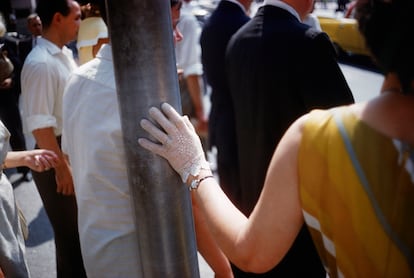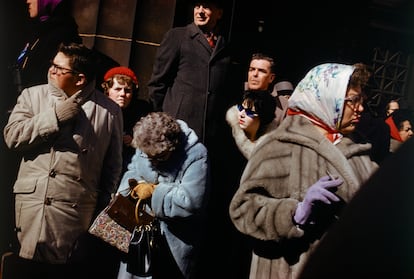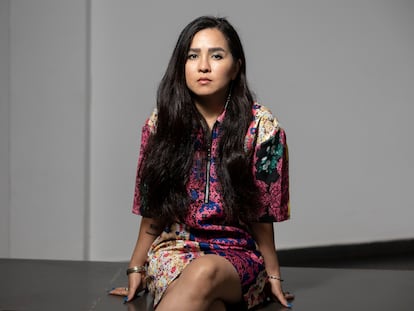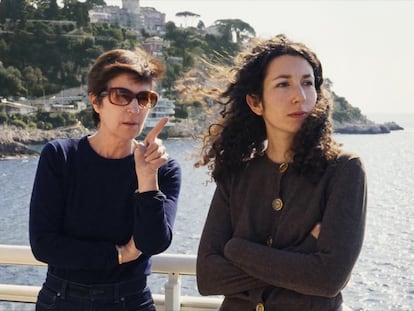Garry Winogrand: Visionary perceptions of everyday life
In the first monograph dedicated to the color images of the prolific master of street photography, the artist’s incisive wit beats with the same rhythm as his powerful black-and-white works
In 1967, an important exhibition opened at the MoMA: New Documents, a modest show, organized by John Szarkowski, destined to mark a major turn in the history of photography. On the first floor of the museum, Garry Winogrand (1928-1984), together with Diane Arbus and Lee Friedlander, offered an original approach to perceiving and reflecting the world — a seemingly carefree and random perspective, which consolidated a shift in our understanding of the photograph as document. Now, the camera not only served as a tool to describe the environment, but as a reflection on the personal interactions a photographer has with their surroundings. In one of the rooms, a carousel projected 80 circulating slides of Winogrand’s works. A few days later, the projector broke and several of the slides were destroyed. This was the first and last time that the photographer would show his images in color.



Although we know Winogrand primarily in black and white, between the early 1950s and late 1960s the photographer produced more than 45,000 images in color. Not surprising, given his increasingly compulsive pace of production in those years, when he was more interested in the act of taking photographs than in editing and printing them (“I photograph to see what things look like photographed,” he famously quipped). Following his sudden and untimely death at the age of 56, Winogrand would leave behind a magnificent number of unpublished images: approximately 2,500 undeveloped film rolls, 6,500 developed but unprinted rolls, and some 3,000 developed negatives only printed on contact sheets. A more than impressive number of works that will undoubtedly inspire diverse interpretations, and which, far from threatening to upset the artist’s enduring reputation, reveal previously unknown creative avenues pursued by the elusive man who once said that “nothing is quite so mysterious as a thing well-described.”
This, indeed, is the case with Winogrand Color (Twin Palms), the first monograph devoted to the little-known color works of the Bronx-raised photographer, the son of European immigrants. The book features a total of 150 images edited by filmmaker and writer Michael Almereyda and former MoMA photography curator Susan Kismaric, who spent a total of four weeks sifting through thousands of Winogrand’s photographs held in collection at the Center for Creative Photography in Tucson, Arizona. They are mostly human-centered images, in which the creator’s sharp wit beats with the same rhythm as his powerful black-and-white works.
Most of the images in the monograph were taken by the artist once he was free of his commissioned obligations, working for publications like Colliers or Sports Illustrated. He never printed, exhibited or published his works in color, and his production decreased from the late 1960s onwards, probably due to the high cost of developing film. Carrying two cameras, one with black-and-white rolls, the other with color, the author consummated his rebellion against the functional and illustrative style demanded by the magazines, while refining his gaze and achieving a level of artistic freedom that is difficult to match. While journalism demands images that explain the world “clearly,” photographs, as John Szarkowski insisted, explain practically nothing. Far from being a defect, however, this ambiguity, he said, is a virtue — something which Winogrand, whose gaze reveals the enlightened beauty of scenes in which, one might say, nothing is happening, was fully aware; for example, the image of a woman, facing away and whose face we can’t see, placing a lace-gloved hand on a pole while surrounded by headless figures (New York, 1961).
The idea for the book was inspired by 30 powerful color images included in Winogrand 64. That book, published in 2002 and no longer in print, juxtaposed Winogrand’s color works with black-and-white images taken during his road trips around the United States and financed by a Guggenheim Fellowship. It wasn’t until an exhibition at the Brooklyn Museum in 2019 — Garry Winogrand: Color — that viewers were able to enjoy the extensive exhibition of more than 400 color slides (the KBr Photography Center in Barcelona put on a version of the exhibition in 2021).
“Winogrand never developed or worked from a theory of color,” says Almereyda. “He accepted color as a natural part of the world, and of his photographs, and in the best ones, color is organic and unforced.” The slower exposure required by color demanded a slower pace from the photographer and tempered Winogrand’s excesses. Hence, his subjects take on a more amiable and delicate tone that sharpens his instinctive ability to uncover intimate interactions and dramas, as seen in Untitled (Coney Island). However, in the color version of his famous photograph Central Park Zoo, New York, the work loses strength and meaning. In each image, one gets the impression that Winogrand, unlike Robert Frank, never felt like an outsider: he portrays a world in which he himself has a place. Thus, color serves as a more immediate lure to draw the viewer into multilayered scenes, which offer ample information and which only the trained eye of a master can portray with such simplicity and lightness.

Szarkowski once wrote that Winogrand’s mission “has not been to reform life, but to know it” — an observation reconfirmed by the collection of color images, which speak for themselves while enveloping viewers in a halo of nostalgia through insightful glimpses into everyday life. If the photographer’s works have been described as the visual equivalent of the literary creations of Phillip Roth and Norman Mailer, perhaps this is because Winogrand was always mindful of the impossibility of translating photographs into words. As critic Vince Aletti writes: “However he navigated the world, he didn’t miss a thing, and he left all of it behind for us to dig through, rediscover, and puzzle over.”
Winogrand Color. Edited by Michael Almereyda and Susan Kismaric. Twin Palms, 176 pages. $85.00.
Tu suscripción se está usando en otro dispositivo
¿Quieres añadir otro usuario a tu suscripción?
Si continúas leyendo en este dispositivo, no se podrá leer en el otro.
FlechaTu suscripción se está usando en otro dispositivo y solo puedes acceder a EL PAÍS desde un dispositivo a la vez.
Si quieres compartir tu cuenta, cambia tu suscripción a la modalidad Premium, así podrás añadir otro usuario. Cada uno accederá con su propia cuenta de email, lo que os permitirá personalizar vuestra experiencia en EL PAÍS.
¿Tienes una suscripción de empresa? Accede aquí para contratar más cuentas.
En el caso de no saber quién está usando tu cuenta, te recomendamos cambiar tu contraseña aquí.
Si decides continuar compartiendo tu cuenta, este mensaje se mostrará en tu dispositivo y en el de la otra persona que está usando tu cuenta de forma indefinida, afectando a tu experiencia de lectura. Puedes consultar aquí los términos y condiciones de la suscripción digital.
More information
Archived In
Últimas noticias
The complicated life of Francesca Albanese: A rising figure in Italy but barred from every bank by Trump’s sanctions
Reinhard Genzel, Nobel laureate in physics: ‘One-minute videos will never give you the truth’
Pinochet’s victims grapple with José Antonio Kast’s rise in Chile
How Japan is trying to avert ‘digital defeat’
Most viewed
- Pablo Escobar’s hippos: A serious environmental problem, 40 years on
- Reinhard Genzel, Nobel laureate in physics: ‘One-minute videos will never give you the truth’
- Why we lost the habit of sleeping in two segments and how that changed our sense of time
- Charles Dubouloz, mountaineering star, retires at 36 with a farewell tour inspired by Walter Bonatti
- The Florida Keys tourist paradise is besieged by immigration agents: ‘We’ve never seen anything like this’











































